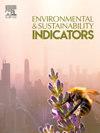Shoreline dynamics and anthropogenic influences on coastal erosion: A multi-temporal analysis for sustainable shoreline management along a southwest coastal district of India
IF 5.4
Q1 ENVIRONMENTAL SCIENCES
引用次数: 0
Abstract
The Thiruvananthapuram coast in South India displays a complex pattern of shoreline dynamics influenced by both natural processes and anthropogenic interventions. While prior studies have examined shoreline sensitivity and seasonal fluctuations, the impacts of urban growth and development on coastal erosion have been less explored. This study aims to address this gap by assessing shoreline changes along the coast using Landsat imagery from 2000 to 2024, focusing on five coastal zones: Neyyattinkara, Vizhinjam, Thiruvananthapuram, Chirayinkeezhu, and Varkala. The analysis highlights significant variations in shoreline movement across these zones, with a combination of erosional and accretional trends influenced by infrastructure developments like harbors, seawalls, and coastal engineering projects. Zones such as Vizhinjam, impacted by port development, show localized erosion due to altered sediment transport, while areas like Karode and Kulattor in Neyyattinkara experience erosion from river mouth dynamics. Additionally, seasonal wave patterns, including wave height variations and longshore currents, contribute to the region's dynamic coastal behavior. The study emphasizes the need for sustainable coastal infrastructure, including eco-friendly seawalls and mangrove restoration, to mitigate erosion and enhance climate resilience. By aligning with SDG 13 (Climate Action) and SDG 14 (Life below water), the research advocates for adaptive management strategies that reduce shoreline degradation, safeguard coastal ecosystems and strengthen the resilience of coastal communities against climate change impacts.
海岸线动态和人为影响对海岸侵蚀的影响:印度西南沿海地区可持续海岸线管理的多时相分析
南印度Thiruvananthapuram海岸显示出受自然过程和人为干预影响的复杂海岸线动态模式。虽然以前的研究考察了海岸线的敏感性和季节波动,但较少探讨城市增长和发展对海岸侵蚀的影响。本研究旨在通过使用2000年至2024年的Landsat图像评估沿海岸线变化来解决这一差距,重点关注五个沿海地区:Neyyattinkara、Vizhinjam、Thiruvananthapuram、Chirayinkeezhu和Varkala。分析强调了这些地区海岸线运动的显著变化,受到港口、海堤和海岸工程项目等基础设施发展的影响,侵蚀和增加趋势结合在一起。像Vizhinjam这样受港口发展影响的地区,由于泥沙运输的改变,显示出局部侵蚀,而像neyattinkara的Karode和Kulattor这样的地区则受到河口动力的侵蚀。此外,季节性波浪模式,包括波高变化和沿岸流,对该地区的动态海岸行为有贡献。该研究强调需要可持续的沿海基础设施,包括生态友好型海堤和红树林恢复,以减轻侵蚀和增强气候适应能力。通过与可持续发展目标13(气候行动)和可持续发展目标14(水下生命)保持一致,该研究倡导采取适应性管理战略,减少海岸线退化,保护沿海生态系统,加强沿海社区抵御气候变化影响的能力。
本文章由计算机程序翻译,如有差异,请以英文原文为准。
求助全文
约1分钟内获得全文
求助全文
来源期刊

Environmental and Sustainability Indicators
Environmental Science-Environmental Science (miscellaneous)
CiteScore
7.80
自引率
2.30%
发文量
49
审稿时长
57 days
 求助内容:
求助内容: 应助结果提醒方式:
应助结果提醒方式:


